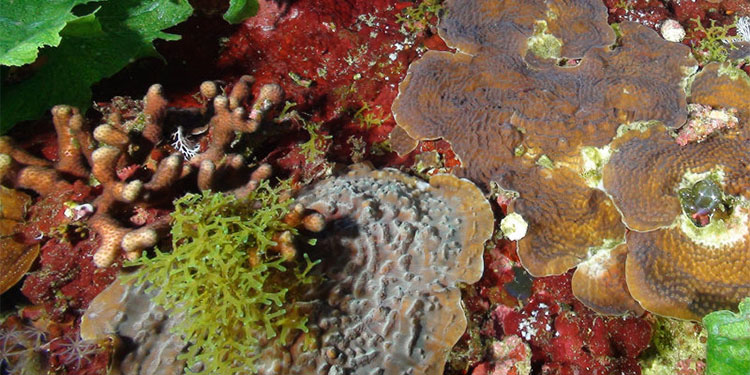Understanding Coral Ecosystem Connectivity in the Gulf of Mexico from Pulley Ridge to the Florida Keys
For more information about the project or additional project publications, visit the Research Project Page
This project began in September 2011 and was completed in February 2018. For more information about this project contact Kimberly Puglise.

Example of corals and algae found on Pulley Ridge: The plate corals Leptoseris cucullata (foreground) and Agaricia fragilis; the finger coral Madracis sp.; the leafy green algae Anadyomene menziesii; and the branching algae Dictyota sp. Photo credit: Mike Echevarria (Florida Aquarium).
The team led by University of Miami investigated the role that the mesophotic coral ecosystems (~60–100 m) of Pulley Ridge (off the southwest coast of Florida) play in replenishing key species in the downstream reefs of the Florida Keys and Dry Tortugas. Because of the well-documented decline of Florida’s reefs, it is important to identify, protect, and manage sources of larval reef species that can help sustain Florida’s reef ecosystems, and the tourism economy that depends on it. This interdisciplinary study focused on determining the connectivity of reef species living at Pulley Ridge, the deepest known photosynthetic coral reef off the continental U.S., to those in the Florida Keys, as well as describing the community structure and determining the economic value of Pulley Ridge’s communities. Focal species for connectivity studies were the red grouper (Epinephelus morio), the bicolor damselfish (Stegastes partitus), the Indo-Pacific lionfish (Pterois spp.), the great star coral (Montastraea cavernosa), lettuce corals (Agaricia spp.), and the giant barrel sponge (Xestospongia muta). The study was advised by a Stakeholder Advisory Board, a collaboration of Federal, state, and nongovernmental stakeholders to ensure the utility of outputs for resource managers.
The project is divided into six separate groups: Physical Oceanography, Biological-physical Modeling, Population Genetics, Population Dynamics, Community Structure, and Bio-economics.
Funding: The NOAA National Centers for Coastal Ocean Science (NCCOS) Competitive Research Program and Office of Ocean Exploration and Research (OER), in partnership with NOAA’s Office of National Marine Sanctuaries, National Marine Fisheries Service’s Southeast Regional Office, and Gulf of Mexico Regional Collaboration Team, supported a team, led by the University of Miami, of over 30 scientists at 9 different universities pooling their expertise with state and Federal agency scientists, through NOAA’s Cooperative Institute for Marine and Atmospheric Studies (CIMAS) at the University of Miami in coordination with the Cooperative Institute for Ocean Exploration, Research, and Technology (CIOERT) at Florida Atlantic University, under awards NA11NOS4780045, NA09OAR4320073, and NA14OAR4320260.
Metadata
Cruise Information
Datasets
Oceanography
- Hydrodynamic Modelling: simulated current velocity and temperature (NCEI Accession 0178799)
- Moored Acoustic Doppler Current Profiler (ADCP) time-series from 08-15-2012 to 06-24-2015 (NCEI Accession 0181331)
- Conductivity-Temperature-Depth (CTD) Cast Data from 08-20-2013 to 08-24-2014 (NCEI Accession 0190533)
- Surface Drifter Buoy Position Data from 08-08-2012 to 05-12-2016 (NCEI Accession 0178107)
- Underway datasets (Rolling Deck to Repository, R2R): R/V F.G. Walton Smith
Biological-physical Modeling
Molecular Data
- Great Star Coral, Montastraea cavernosa
Community Structure
- Habitat and Benthic Macrobiota from Underwater Still Images from 2012-08-17 to 2015-09-02 (NCEI Accession 0210993)
Publications
DISCLAIMER: National Oceanic and Atmospheric Administration (NOAA) makes no warranty, expressed or implied, regarding these data, nor does the fact of distribution constitute such a warranty. NOAA cannot assume liability for any damages caused by any errors or omissions in these data. Please see the metadata records for each data set for complete information on the source, limitations, and proper use.